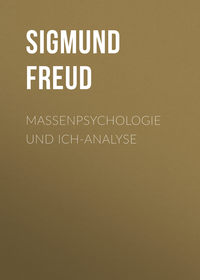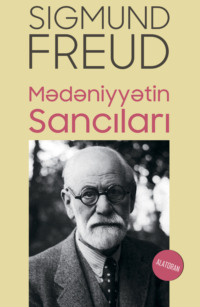 полная версия
полная версияDream Psychology: Psychoanalysis for Beginners
The conclusion which is now forced upon me is that the dream is a sort of substitution for those emotional and intellectual trains of thought which I attained after complete analysis. I do not yet know the process by which the dream arose from those thoughts, but I perceive that it is wrong to regard the dream as psychically unimportant, a purely physical process which has arisen from the activity of isolated cortical elements awakened out of sleep.
I must further remark that the dream is far shorter than the thoughts which I hold it replaces; whilst analysis discovered that the dream was provoked by an unimportant occurrence the evening before the dream.
Naturally, I would not draw such far-reaching conclusions if only one analysis were known to me. Experience has shown me that when the associations of any dream are honestly followed such a chain of thought is revealed, the constituent parts of the dream reappear correctly and sensibly linked together; the slight suspicion that this concatenation was merely an accident of a single first observation must, therefore, be absolutely relinquished. I regard it, therefore, as my right to establish this new view by a proper nomenclature. I contrast the dream which my memory evokes with the dream and other added matter revealed by analysis: the former I call the dream's manifest content; the latter, without at first further subdivision, its latent content. I arrive at two new problems hitherto unformulated: (1) What is the psychical process which has transformed the latent content of the dream into its manifest content? (2) What is the motive or the motives which have made such transformation exigent? The process by which the change from latent to manifest content is executed I name the dream-work. In contrast with this is the work of analysis, which produces the reverse transformation. The other problems of the dream – the inquiry as to its stimuli, as to the source of its materials, as to its possible purpose, the function of dreaming, the forgetting of dreams – these I will discuss in connection with the latent dream-content.
I shall take every care to avoid a confusion between the manifest and the latent content, for I ascribe all the contradictory as well as the incorrect accounts of dream-life to the ignorance of this latent content, now first laid bare through analysis.
The conversion of the latent dream thoughts into those manifest deserves our close study as the first known example of the transformation of psychical stuff from one mode of expression into another. From a mode of expression which, moreover, is readily intelligible into another which we can only penetrate by effort and with guidance, although this new mode must be equally reckoned as an effort of our own psychical activity. From the standpoint of the relationship of latent to manifest dream-content, dreams can be divided into three classes. We can, in the first place, distinguish those dreams which have a meaning and are, at the same time, intelligible, which allow us to penetrate into our psychical life without further ado. Such dreams are numerous; they are usually short, and, as a general rule, do not seem very noticeable, because everything remarkable or exciting surprise is absent. Their occurrence is, moreover, a strong argument against the doctrine which derives the dream from the isolated activity of certain cortical elements. All signs of a lowered or subdivided psychical activity are wanting. Yet we never raise any objection to characterizing them as dreams, nor do we confound them with the products of our waking life.
A second group is formed by those dreams which are indeed self-coherent and have a distinct meaning, but appear strange because we are unable to reconcile their meaning with our mental life. That is the case when we dream, for instance, that some dear relative has died of plague when we know of no ground for expecting, apprehending, or assuming anything of the sort; we can only ask ourself wonderingly: "What brought that into my head?" To the third group those dreams belong which are void of both meaning and intelligibility; they are incoherent, complicated, and meaningless. The overwhelming number of our dreams partake of this character, and this has given rise to the contemptuous attitude towards dreams and the medical theory of their limited psychical activity. It is especially in the longer and more complicated dream-plots that signs of incoherence are seldom missing.
The contrast between manifest and latent dream-content is clearly only of value for the dreams of the second and more especially for those of the third class. Here are problems which are only solved when the manifest dream is replaced by its latent content; it was an example of this kind, a complicated and unintelligible dream, that we subjected to analysis. Against our expectation we, however, struck upon reasons which prevented a complete cognizance of the latent dream thought. On the repetition of this same experience we were forced to the supposition that there is an intimate bond, with laws of its own, between the unintelligible and complicated nature of the dream and the difficulties attending communication of the thoughts connected with the dream. Before investigating the nature of this bond, it will be advantageous to turn our attention to the more readily intelligible dreams of the first class where, the manifest and latent content being identical, the dream work seems to be omitted.
The investigation of these dreams is also advisable from another standpoint. The dreams of children are of this nature; they have a meaning, and are not bizarre. This, by the way, is a further objection to reducing dreams to a dissociation of cerebral activity in sleep, for why should such a lowering of psychical functions belong to the nature of sleep in adults, but not in children? We are, however, fully justified in expecting that the explanation of psychical processes in children, essentially simplified as they may be, should serve as an indispensable preparation towards the psychology of the adult.
I shall therefore cite some examples of dreams which I have gathered from children. A girl of nineteen months was made to go without food for a day because she had been sick in the morning, and, according to nurse, had made herself ill through eating strawberries. During the night, after her day of fasting, she was heard calling out her name during sleep, and adding: "Tawberry, eggs, pap." She is dreaming that she is eating, and selects out of her menu exactly what she supposes she will not get much of just now.
The same kind of dream about a forbidden dish was that of a little boy of twenty-two months. The day before he was told to offer his uncle a present of a small basket of cherries, of which the child was, of course, only allowed one to taste. He woke up with the joyful news: "Hermann eaten up all the cherries."
A girl of three and a half years had made during the day a sea trip which was too short for her, and she cried when she had to get out of the boat. The next morning her story was that during the night she had been on the sea, thus continuing the interrupted trip.
A boy of five and a half years was not at all pleased with his party during a walk in the Dachstein region. Whenever a new peak came into sight he asked if that were the Dachstein, and, finally, refused to accompany the party to the waterfall. His behavior was ascribed to fatigue; but a better explanation was forthcoming when the next morning he told his dream: he had ascended the Dachstein. Obviously he expected the ascent of the Dachstein to be the object of the excursion, and was vexed by not getting a glimpse of the mountain. The dream gave him what the day had withheld. The dream of a girl of six was similar; her father had cut short the walk before reaching the promised objective on account of the lateness of the hour. On the way back she noticed a signpost giving the name of another place for excursions; her father promised to take her there also some other day. She greeted her father next day with the news that she had dreamt that her father had been with her to both places.
What is common in all these dreams is obvious. They completely satisfy wishes excited during the day which remain unrealized. They are simply and undisguisedly realizations of wishes.
The following child-dream, not quite understandable at first sight, is nothing else than a wish realized. On account of poliomyelitis a girl, not quite four years of age, was brought from the country into town, and remained over night with a childless aunt in a big – for her, naturally, huge – bed. The next morning she stated that she had dreamt that the bed was much too small for her, so that she could find no place in it. To explain this dream as a wish is easy when we remember that to be "big" is a frequently expressed wish of all children. The bigness of the bed reminded Miss Little-Would-be-Big only too forcibly of her smallness. This nasty situation became righted in her dream, and she grew so big that the bed now became too small for her.
Even when children's dreams are complicated and polished, their comprehension as a realization of desire is fairly evident. A boy of eight dreamt that he was being driven with Achilles in a war-chariot, guided by Diomedes. The day before he was assiduously reading about great heroes. It is easy to show that he took these heroes as his models, and regretted that he was not living in those days.
From this short collection a further characteristic of the dreams of children is manifest —their connection with the life of the day. The desires which are realized in these dreams are left over from the day or, as a rule, the day previous, and the feeling has become intently emphasized and fixed during the day thoughts. Accidental and indifferent matters, or what must appear so to the child, find no acceptance in the contents of the dream.
Innumerable instances of such dreams of the infantile type can be found among adults also, but, as mentioned, these are mostly exactly like the manifest content. Thus, a random selection of persons will generally respond to thirst at night-time with a dream about drinking, thus striving to get rid of the sensation and to let sleep continue. Many persons frequently have these comforting dreams before waking, just when they are called. They then dream that they are already up, that they are washing, or already in school, at the office, etc., where they ought to be at a given time. The night before an intended journey one not infrequently dreams that one has already arrived at the destination; before going to a play or to a party the dream not infrequently anticipates, in impatience, as it were, the expected pleasure. At other times the dream expresses the realization of the desire somewhat indirectly; some connection, some sequel must be known – the first step towards recognizing the desire. Thus, when a husband related to me the dream of his young wife, that her monthly period had begun, I had to bethink myself that the young wife would have expected a pregnancy if the period had been absent. The dream is then a sign of pregnancy. Its meaning is that it shows the wish realized that pregnancy should not occur just yet. Under unusual and extreme circumstances, these dreams of the infantile type become very frequent. The leader of a polar expedition tells us, for instance, that during the wintering amid the ice the crew, with their monotonous diet and slight rations, dreamt regularly, like children, of fine meals, of mountains of tobacco, and of home.
It is not uncommon that out of some long, complicated and intricate dream one specially lucid part stands out containing unmistakably the realization of a desire, but bound up with much unintelligible matter. On more frequently analyzing the seemingly more transparent dreams of adults, it is astonishing to discover that these are rarely as simple as the dreams of children, and that they cover another meaning beyond that of the realization of a wish.
It would certainly be a simple and convenient solution of the riddle if the work of analysis made it at all possible for us to trace the meaningless and intricate dreams of adults back to the infantile type, to the realization of some intensely experienced desire of the day. But there is no warrant for such an expectation. Their dreams are generally full of the most indifferent and bizarre matter, and no trace of the realization of the wish is to be found in their content.
Before leaving these infantile dreams, which are obviously unrealized desires, we must not fail to mention another chief characteristic of dreams, one that has been long noticed, and one which stands out most clearly in this class. I can replace any of these dreams by a phrase expressing a desire. If the sea trip had only lasted longer; if I were only washed and dressed; if I had only been allowed to keep the cherries instead of giving them to my uncle. But the dream gives something more than the choice, for here the desire is already realized; its realization is real and actual. The dream presentations consist chiefly, if not wholly, of scenes and mainly of visual sense images. Hence a kind of transformation is not entirely absent in this class of dreams, and this may be fairly designated as the dream work. An idea merely existing in the region of possibility is replaced by a vision of its accomplishment.
II
THE DREAM MECHANISM
We are compelled to assume that such transformation of scene has also taken place in intricate dreams, though we do not know whether it has encountered any possible desire. The dream instanced at the commencement, which we analyzed somewhat thoroughly, did give us occasion in two places to suspect something of the kind. Analysis brought out that my wife was occupied with others at table, and that I did not like it; in the dream itself exactly the opposite occurs, for the person who replaces my wife gives me her undivided attention. But can one wish for anything pleasanter after a disagreeable incident than that the exact contrary should have occurred, just as the dream has it? The stinging thought in the analysis, that I have never had anything for nothing, is similarly connected with the woman's remark in the dream: "You have always had such beautiful eyes." Some portion of the opposition between the latent and manifest content of the dream must be therefore derived from the realization of a wish.
Another manifestation of the dream work which all incoherent dreams have in common is still more noticeable. Choose any instance, and compare the number of separate elements in it, or the extent of the dream, if written down, with the dream thoughts yielded by analysis, and of which but a trace can be refound in the dream itself. There can be no doubt that the dream working has resulted in an extraordinary compression or condensation. It is not at first easy to form an opinion as to the extent of the condensation; the more deeply you go into the analysis, the more deeply you are impressed by it. There will be found no factor in the dream whence the chains of associations do not lead in two or more directions, no scene which has not been pieced together out of two or more impressions and events. For instance, I once dreamt about a kind of swimming-bath where the bathers suddenly separated in all directions; at one place on the edge a person stood bending towards one of the bathers as if to drag him out. The scene was a composite one, made up out of an event that occurred at the time of puberty, and of two pictures, one of which I had seen just shortly before the dream. The two pictures were The Surprise in the Bath, from Schwind's Cycle of the Melusine (note the bathers suddenly separating), and The Flood, by an Italian master. The little incident was that I once witnessed a lady, who had tarried in the swimming-bath until the men's hour, being helped out of the water by the swimming-master. The scene in the dream which was selected for analysis led to a whole group of reminiscences, each one of which had contributed to the dream content. First of all came the little episode from the time of my courting, of which I have already spoken; the pressure of a hand under the table gave rise in the dream to the "under the table," which I had subsequently to find a place for in my recollection. There was, of course, at the time not a word about "undivided attention." Analysis taught me that this factor is the realization of a desire through its contradictory and related to the behavior of my wife at the table d'hôte. An exactly similar and much more important episode of our courtship, one which separated us for an entire day, lies hidden behind this recent recollection. The intimacy, the hand resting upon the knee, refers to a quite different connection and to quite other persons. This element in the dream becomes again the starting-point of two distinct series of reminiscences, and so on.
The stuff of the dream thoughts which has been accumulated for the formation of the dream scene must be naturally fit for this application. There must be one or more common factors. The dream work proceeds like Francis Galton with his family photographs. The different elements are put one on top of the other; what is common to the composite picture stands out clearly, the opposing details cancel each other. This process of reproduction partly explains the wavering statements, of a peculiar vagueness, in so many elements of the dream. For the interpretation of dreams this rule holds good: When analysis discloses uncertainty, as to either—or read and, taking each section of the apparent alternatives as a separate outlet for a series of impressions.
When there is nothing in common between the dream thoughts, the dream work takes the trouble to create a something, in order to make a common presentation feasible in the dream. The simplest way to approximate two dream thoughts, which have as yet nothing in common, consists in making such a change in the actual expression of one idea as will meet a slight responsive recasting in the form of the other idea. The process is analogous to that of rhyme, when consonance supplies the desired common factor. A good deal of the dream work consists in the creation of those frequently very witty, but often exaggerated, digressions. These vary from the common presentation in the dream content to dream thoughts which are as varied as are the causes in form and essence which give rise to them. In the analysis of our example of a dream, I find a like case of the transformation of a thought in order that it might agree with another essentially foreign one. In following out the analysis I struck upon the thought: I should like to have something for nothing. But this formula is not serviceable to the dream. Hence it is replaced by another one: "I should like to enjoy something free of cost."1 The word "kost" (taste), with its double meaning, is appropriate to a table d'hôte; it, moreover, is in place through the special sense in the dream. At home if there is a dish which the children decline, their mother first tries gentle persuasion, with a "Just taste it." That the dream work should unhesitatingly use the double meaning of the word is certainly remarkable; ample experience has shown, however, that the occurrence is quite usual.
Through condensation of the dream certain constituent parts of its content are explicable which are peculiar to the dream life alone, and which are not found in the waking state. Such are the composite and mixed persons, the extraordinary mixed figures, creations comparable with the fantastic animal compositions of Orientals; a moment's thought and these are reduced to unity, whilst the fancies of the dream are ever formed anew in an inexhaustible profusion. Every one knows such images in his own dreams; manifold are their origins. I can build up a person by borrowing one feature from one person and one from another, or by giving to the form of one the name of another in my dream. I can also visualize one person, but place him in a position which has occurred to another. There is a meaning in all these cases when different persons are amalgamated into one substitute. Such cases denote an "and," a "just like," a comparison of the original person from a certain point of view, a comparison which can be also realized in the dream itself. As a rule, however, the identity of the blended persons is only discoverable by analysis, and is only indicated in the dream content by the formation of the "combined" person.
The same diversity in their ways of formation and the same rules for its solution hold good also for the innumerable medley of dream contents, examples of which I need scarcely adduce. Their strangeness quite disappears when we resolve not to place them on a level with the objects of perception as known to us when awake, but to remember that they represent the art of dream condensation by an exclusion of unnecessary detail. Prominence is given to the common character of the combination. Analysis must also generally supply the common features. The dream says simply: All these things have an "x" in common. The decomposition of these mixed images by analysis is often the quickest way to an interpretation of the dream. Thus I once dreamt that I was sitting with one of my former university tutors on a bench, which was undergoing a rapid continuous movement amidst other benches. This was a combination of lecture-room and moving staircase. I will not pursue the further result of the thought. Another time I was sitting in a carriage, and on my lap an object in shape like a top-hat, which, however, was made of transparent glass. The scene at once brought to my mind the proverb: "He who keeps his hat in his hand will travel safely through the land." By a slight turn the glass hat reminded me of Auer's light, and I knew that I was about to invent something which was to make me as rich and independent as his invention had made my countryman, Dr. Auer, of Welsbach; then I should be able to travel instead of remaining in Vienna. In the dream I was traveling with my invention, with the, it is true, rather awkward glass top-hat. The dream work is peculiarly adept at representing two contradictory conceptions by means of the same mixed image. Thus, for instance, a woman dreamt of herself carrying a tall flower-stalk, as in the picture of the Annunciation (Chastity-Mary is her own name), but the stalk was bedecked with thick white blossoms resembling camellias (contrast with chastity: La dame aux Camelias).
A great deal of what we have called "dream condensation" can be thus formulated. Each one of the elements of the dream content is overdetermined by the matter of the dream thoughts; it is not derived from one element of these thoughts, but from a whole series. These are not necessarily interconnected in any way, but may belong to the most diverse spheres of thought. The dream element truly represents all this disparate matter in the dream content. Analysis, moreover, discloses another side of the relationship between dream content and dream thoughts. Just as one element of the dream leads to associations with several dream thoughts, so, as a rule, the one dream thought represents more than one dream element. The threads of the association do not simply converge from the dream thoughts to the dream content, but on the way they overlap and interweave in every way.
Next to the transformation of one thought in the scene (its "dramatization"), condensation is the most important and most characteristic feature of the dream work. We have as yet no clue as to the motive calling for such compression of the content.
In the complicated and intricate dreams with which we are now concerned, condensation and dramatization do not wholly account for the difference between dream contents and dream thoughts. There is evidence of a third factor, which deserves careful consideration.
When I have arrived at an understanding of the dream thoughts by my analysis I notice, above all, that the matter of the manifest is very different from that of the latent dream content. That is, I admit, only an apparent difference which vanishes on closer investigation, for in the end I find the whole dream content carried out in the dream thoughts, nearly all the dream thoughts again represented in the dream content. Nevertheless, there does remain a certain amount of difference.











